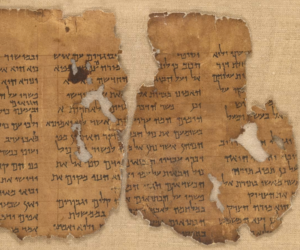Did the earliest Gospels use Hebrew letters for the Tetragrammaton?
Many early copies of the New Testament abbreviate sacred words (nomina sacra). The earliest of these abbreviations stand for “God,” “Lord,” “Christ,” and “Jesus.” Abbreviations of these words were formed by writing their first and last letters and placing a line over them. Thus, using English to illustrate, “God” would appear asG ÷D÷ and “Lord” as L÷D÷.
The attempt to differentiate and dignify the sacred name of God goes back to pre-Christian times; it was done first by Jews.
From the Dead Sea Scrolls we know that Jewish scribes often distinguished the divine name Yahweh. (Yahweh is known as the Tetragrammaton because it consists of four consonant Hebrew letters, yod, he, vav, he, often written in English YHWH.) Frequently, the scribes who wrote the Dead Sea Scrolls would write the Tetragrammaton in old paleo-Hebrew script, although the scroll was otherwise written in square Aramaic script. An example is the Habakkuk commentary found in cave 1. In the portion reproduced in the color photograph, the Tetragrammaton appears twice in paleo-Hebrew script on line 7 word 3 (reading from right to left) and on line 14 word 7.
Read the rest of The Name of God in the New Testament in the online Biblical Archaeology Society Library.
